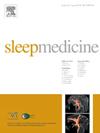An inter-rater variability study between human and automatic scorers in 5-s mini-epochs of sleep
IF 3.8
2区 医学
Q1 CLINICAL NEUROLOGY
引用次数: 0
Abstract
Study objective
Sleep is traditionally scored using 30-s epochs of polysomnographies. As sleep is physiologically dynamic and 30-s epochs may conceal important characteristics, we aim to challenge this standard by scoring sleep in 5-s mini-epochs and analyzing inter-rater variability between human and automatic scorers.
Methods
In 40 polysomnography recordings, 120 mini-epochs per polysomnography were scored manually by three human experts (expert1_5s, expert2_5s and expert3_5s) and automatically by a validated sleep classifier (USleep_5s). Additionally, 5-s mini-epochs (clinical_5s) extracted from conventional human-scored 30-s epochs were considered. We assessed inter-rater variability and stage shifting in epochs and mini-epochs and further in narcolepsy type 1 (NT1) patients and siblings.
Results
Agreement for mini-epochs was κ = 0.50 ± 0.11 (expert1_5s vs clinical_5s) and κ = 0.51 ± 0.12, (expert1_5s vs USleep_5s). Between human experts, agreement was κ = 0.51 ± 0.16 (expert1_5s vs expert2_5s), and κ = 0.57 ± 0.11 (expert1_5s vs expert3_5s). Stage shift percentages were significantly higher in mini-epochs scored by expert1_5s (27.75 %) and USleep_5s (22.88 %) than corresponding conventional epochs (5.12 %), with no significant difference between NT1 patients and siblings.
Conclusion
While mini-epoch scoring agreement was generally high, it was still lower than within epochs, likely due to a lack of standard mini-epoch scoring procedure and the automatic classifier being trained on epochs. However, stage discrepancies between epochs and mini-epochs and increased stage shifting in mini-epochs support that epochs can contain several stages, and that mini-epochs could supplement more detailed sleep characterization potentially enabling more precise diagnosis and finding new polysomnographic biomarkers. Future studies should include larger datasets to refine mini-epoch scoring rules and exploit automatic classifiers e.g. via transfer learning.

求助全文
约1分钟内获得全文
求助全文
来源期刊

Sleep medicine
医学-临床神经学
CiteScore
8.40
自引率
6.20%
发文量
1060
审稿时长
49 days
期刊介绍:
Sleep Medicine aims to be a journal no one involved in clinical sleep medicine can do without.
A journal primarily focussing on the human aspects of sleep, integrating the various disciplines that are involved in sleep medicine: neurology, clinical neurophysiology, internal medicine (particularly pulmonology and cardiology), psychology, psychiatry, sleep technology, pediatrics, neurosurgery, otorhinolaryngology, and dentistry.
The journal publishes the following types of articles: Reviews (also intended as a way to bridge the gap between basic sleep research and clinical relevance); Original Research Articles; Full-length articles; Brief communications; Controversies; Case reports; Letters to the Editor; Journal search and commentaries; Book reviews; Meeting announcements; Listing of relevant organisations plus web sites.
 求助内容:
求助内容: 应助结果提醒方式:
应助结果提醒方式:


